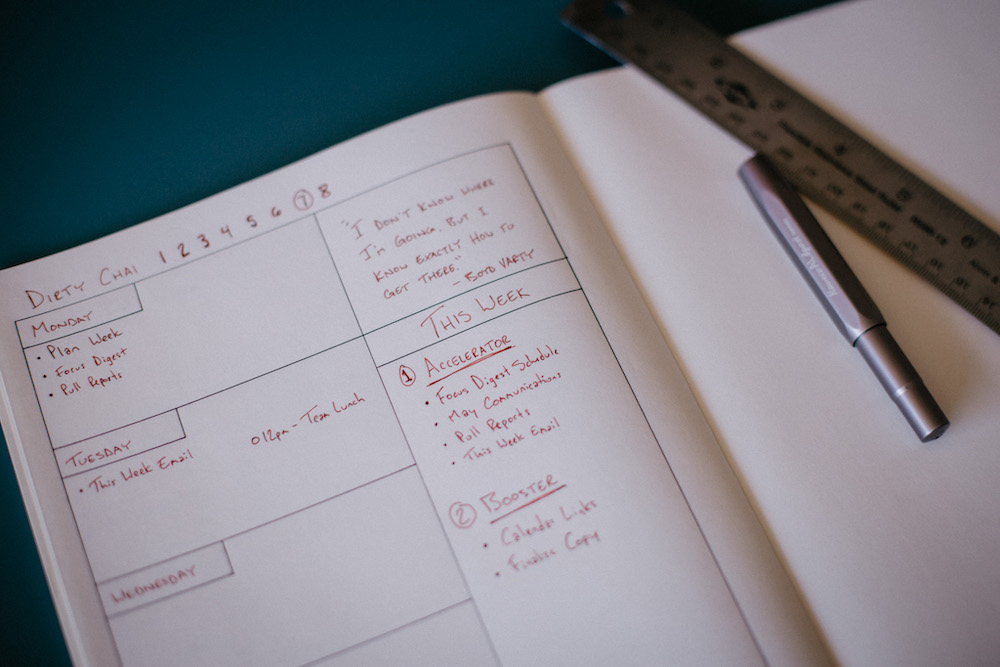How to Create an Effective Weekly Schedule

How to Create an Effective Weekly Schedule
Have you ever finished a week feeling like your to-do list got longer with each passing day?
Even though each day was a flurry of activity, it feels like no matter how hard you try and regardless of how much you do, it seems impossible to make progress. I can relate. And there were a lot of weeks this was my reality.
But it’s been a while since I’ve had one of those weeks. And as a whole, they have become a lot less common. I would attribute much of this due to my weekly and daily planning process.
Every Monday for the past 5 years, I’ve taken the first 15 minutes to plan the week ahead.
For me, this has been my single greatest productivity routine. Before being sucked in to the myriad of inboxes and notifications, I take a brief moment to identify and plan what is truly important for the week ahead.
Part of this planning process includes accounting for the unmovable rocks in my schedule. Meetings, errands, when the kids need picking up, the things I know are going to happen on a specific day and time. These events act as guardrails in my schedule. Hard stopping points in which I know I’ll have to transition out of “get things done” mode.
With a framework of my week sketched out, I set myself to the task of painting what done or progress looks like. First, what two or three projects do I need to push forward? Second, what are the two to four tasks associated with each project? And what does “done” mean? The more specific the better.
Targets
In every sport, there is a clear objective — get the ball into the basket, hit the target, get to home base, etc. Strategy and tactics may differ, but ultimately there is clarity on what it means to win. That clarity allows for an endless number of ways to achieve success. The rules and boundaries actually cause creativity to thrive within their confines.
When we give ourselves clear objectives (targets) to aim for through planning, we increase our ability to be creative. A lack of clarity leads to confusion, inefficiency, and ultimately, frustration.
When there is a lack of clarity, people waste time and energy on the trivial many. When they have sufficient levels of clarity, they are capable of greater breakthroughs and innovations—greater than people even realize they ought to have—in those areas that are truly vital. —Greg McKeown
For me, the planning process gives me time and space to identify what is truly important. This results in clarity of what needs to be done. That clarity moves me to precise action.
Winning Each Day
Once I’ve outlined my weekly plan, I turn my attention to the day ahead.

The same principles that guide my weekly plan are also true for daily planning. Greater clarity on what I’m trying to accomplish leads to taking action.
This does not mean my tasks do not involve any level of ambiguity. Often in the doing of something, greater clarity comes as a result. I try to remove any guesswork for myself in planning out my tasks.
Instead of assigning myself the task, “write weekly newsletter” I may start with instead “outline weekly newsletter on restoring margin.” A smaller, bite-size, specific task.
I’ve found my limit is typically three important tasks (MITs) for each day. And usually I only have enough brain power for two deep work tasks. Things that require a large chunk of un-interrupted focus and creativity. If I assign myself five deep work tasks in a single day, it’s unlikely I’ll get through three of them, and I’ll finish the day feeling behind.
The real secret to winning each day has been planning my three MITs the day before.
At the end of each day I review what I accomplished and compare that to my plan for the week. Then, I look at my schedule for the next day and plan the two to three tasks I will tackle.
* * *
All of this leads to a remarkable level of calm and responsiveness to my work, rather than feeling frantic and reactive.
I’m able to be proactive in managing my workload rather than just surviving the dog-pile nature of incoming requests.
The more I lean into the 4-Focus Method, the more I find it working for me.
IDENTIFY → PLAN → ACT → CELEBRATE

My 15-minute planning session on Monday mornings has changed the way I get work done. And thankfully, it’s rare to find myself absolutely buried on Friday as I wrap up my week.
There will always be more work to do, but I know I’ll be able to plan for it when I’m back in the saddle on Monday.
(P.S. We’re re-launching our task and time management course All the Things next month (May). 🙌 In which we cover weekly and daily planning extensively.)
